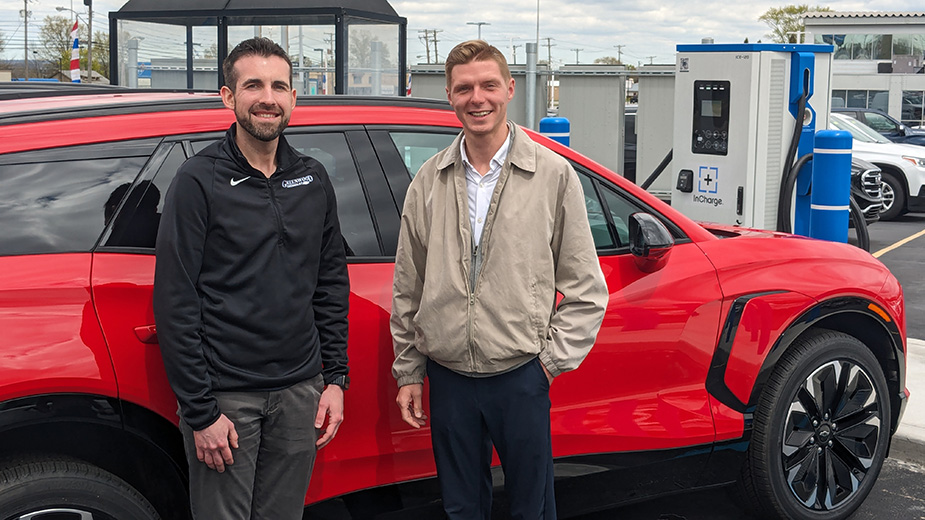EV Technology Improves as Consumers Weigh Options
AUSTINTOWN – Within the span of approximately two years, improved battery technology used in electric vehicles has led to pronounced upgrades in range and charging times, making the option of owning an EV more inviting in a shifting market, specialists say.
New EV models slated for release this year from General Motors Co.’s Chevrolet brand exemplify just how far energy storage and charging technology has come in a fairly short period of time, says Jim Conlin, new-vehicle manager at Greenwood Chevrolet in Austintown.
“Starting with the Bolt, we were around the 240-mile range with that vehicle,” he says, referring to the single charge life, Some of Chevrolet’s newest products, however, due in showrooms soon – the highly anticipated Silverado EV pickup, for example – demonstrate that EV battery capacity is improving with each model. “Now, we’re talking about the Silverado, with a range of up to 440 miles,” he says.
Key to these improvements is GM’s Ultium platform, Conlin says. The Silverado, he continues, not only boasts a range of 440 miles on a single charge, the Ultium platform allows for dramatically reduced charging times. “The Ultium platform has the capability of charging up to 100 miles in 10 minutes,” provided the motorist uses a DC 350 kilowatt-hour fast charger, he says.
By contrast, it could take up to nine hours to fill the Chevrolet Bolt with a 60 kilowatt-hour charge, according to Conlin.
“The biggest consumer concern is the range of the vehicle and the speed of recharging that vehicle,” he says. Larger battery capacity helps to ease these concerns somewhat, especially on EV models such as the Silverado and Equinox, also slated for production in the coming weeks.
“The Equinox will have over a 300-mile range,” Conlin says. The new Equinox has a price point of $41,900, close to the sticker price of its gas-powered version.“We already have some Equinoxes produced and we have our Silverados to follow,” he says. “More than likely, within the next 60 to 90 days we’ll have the vehicles on the lot.”
Meanwhile, Greenwood has five Chevrolet Blazer EVs – three LT and two RS models – for sale, the most the dealership has ever had, says Kevin Lawson, EV specialist and sales and leasing consultant. In March, General Motors announced a price reduction in the Blazer EV after sales restarted. Sales of the vehicle were halted in late December to address software issues.
“We’re really happy about the price reduction,” Lawson says. “It takes about $6,000 off the electric Blazer. It gives us a sense of security when customers look at this vehicle and ask whether it’s really attainable. And the answer is yes. It is.”
Another move that GM has made to attract customers into the EV market is the Ultium Promise, Lawson says. Under this program, GM would provide a $7,500 rebate on vehicles that do not qualify for the federal tax credit of the same amount.
“Right now, we have some Blazers that don’t qualify for the tax credit,” he says. “The great news is that Ultium Promise does not have an income cap. I think that’s been one of the big changes in the market.”
The combined effect of a lower price on the EV Blazer plus the Ultium Promise has helped to drive more inquiries about the EV market, Lawson says. “Those things have generated more interest in the Blazer EV,” he says. Plus, the Blazer boasts new technological features such as the introduction of software that can change the color of ambient lighting in the vehicle.
“We’re seeing technology really evolve,” Lawson says. “We’re seeing longer, faster charging speeds, longer ranges.” The battery capacity for the EV Blazer, for example, began last year at about 280 miles per charge. Today the vehicle is able to travel some 320 miles on a single charge. “We’re just getting better,” he says.
Still, consumers have their share of jitters when it comes to committing to the EV market.
Range anxiety, the slow construction pace of EV charging infrastructure and the prospect of home charging are all questions customers have when it comes to considering an EV. “One of the biggest questions is, ‘How do I charge at home? Who installs it? Where do I get the charger?’ ” Lawson says.
He points out the dealership can secure a Level 2 charging unit from its parts department that is compatible with the model the customer wants.
“We could set you up with some of our electricians who we work with locally to make it a seamless process,” he says.
Analysts say consumer apprehension toward EVs is not unusual as this new technology begins to filter its way through to the buying public. Early adopters helped to drive eye-popping growth in the EV market over the past three years.
It was expected that U.S. sales would cool as newer, more cautious buyers entered the market. As a result, the growth rate of EV sales slowed during the first quarter, data show.
According to Kelley Blue Book, Americans purchased 268,909 EVs during the quarter ended March 31, a 2.6% increase compared to the first quarter of 2023. EV sales slipped by 15.2%, however, during Q1 compared to the last quarter of last year
Among the brands taking the biggest hit was Tesla, which witnessed its market share fall to 51.3% during the quarter from 61.7% during the same period a year earlier. Overall Tesla sales were down 13.3% year-over-year.
Tesla’s decrease in market share points to more competition in the EV space, which is good news for brands such as Chevrolet, which has already introduced the Blazer EV SUV and plans to launch the Equinox EV and the new Silverado EV. Plus, GM has intentions on reviving the entry-level Bolt sometime in 2025 – redesigned and equipped with an Ultium battery platform.
For those who still might be squeamish about full EV adoption, Greenwood’s Conlin says that GM has dropped some hints about reintroducing plug-in hybrid models to North America. In January, GM CEO Mary Barra told analysts that the automaker would add plug-in hybrid technology to as yet unnamed vehicles. GM built its last hybrid – the Chevrolet Volt – from 2010 to 2019.
Such a move would help to bridge a transition from combustion engines to an all-electric vehicle because hybrids operate on both a battery and a traditional gas-powered engine, Conlin says. It would also buy more time for the United States to further develop charging technology across the country.
“We don’t have an exact timeline, or what products will incorporate the hybrid, but it’s a great transition,” Conlin says. “As we’re getting used to EVs, it’s a vehicle you can plug in when you can. But you can also utilize gasoline and travel long distances without having to worry about stops.”
Pictured at top: Jim Conlin, left, and Kevin Lawson say the price has come down on Chevrolet Blazer EV models.
“On the Road to EVs” is sponsored by Greenwood Chevrolet.
Copyright 2024 The Business Journal, Youngstown, Ohio.



